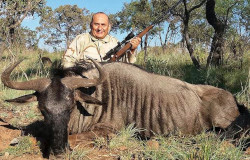


| Name | Blue Wildebeest or Brindled Gnu |
| Scientific Name | Connochaetes Taurinus |
| Average Weight Male | 250 kg |
| Average Weight Female | 180 kg |
| Shoulder Height Male | 150 cm |
| Shoulder Height Female | 135 cm |
| Mating Season | March / April and May |

Hunting blue wildebeest, or the brindled gnu, as he is also known, can be most exciting. This large, bearded antelope, native to the acacia savanna and
short grass plains is often referred to as the 'poor man’s' buffalo. His numbers have dwindled somewhat in many of his old habitats, but he is as plentiful
as ever on the Serengeti ecosystem where his numbers may well exceed one million. The game ranches of southern Africa maintain managed populations of this
'beest', which offer wonderful opportunities for hunting blue wildebeest. As both sexes carry horns and are of similar body size and color, sorting out the
bulls from the cows can sometimes be difficult. Look for heavier muscled individuals with thicker horn bases and more droop.
Older bulls will usually appear darker in color with wider stripes. Mature bulls can weigh as much as 600 pounds. On the open plains, the wildebeest is easy
to locate from a distance, however, hunting blue wildebeest in the bushveld is quite another story. In the bush, he can be elusive and shy; a good technique
is to walk slowly into a suspected resting area into or across the wind glassing well ahead for movement. This is one tough antelope; hunting blue wildebeest
with less than .270 caliber and a good 150-grain bullet is not recommended. In open country, the flat shooting .300 magnums with 200 or 220-grain bullets are
an excellent choice.
Hunting blue wildebeest in bushveld conditions may well call for even larger calibers and heavier bullets. The prominent hump on the
shoulder and the mane may often lead to a body shot placed too high. When hunting blue wildebeest, always try to position yourself for the side-on
shot; draw up the back edge of the front leg and place the shot about four inches (a hand’s width) above the point of the elbow. This 'high heart' shot
will take heart and lungs; the animal will rock to the shot and probably go down within 50 yards. If your shot placement is not quite on the mark,
be very cautious in a follow-up. This critter can be extremely dangerous when wounded. Approach a downed wildebeest from the 'off' side with great care,
as they have been known to get up and charge.